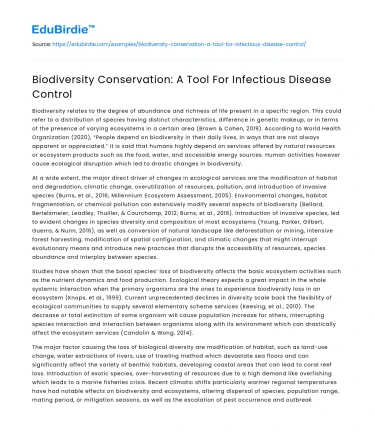Biodiversity relates to the degree of abundance and richness of life present in a specific region. This could refer to a distribution of species having distinct characteristics, difference in genetic makeup, or in terms of the presence of varying ecosystems in a certain area (Brown & Cohen, 2019). According to World Health Organization (2020), “People depend on biodiversity in their daily lives, in ways that are not always apparent or appreciated.” It is said that humans highly depend on services offered by natural resources or ecosystem products such as the food, water, and accessible energy sources. Human activities however cause ecological disruption which led to drastic changes in biodiversity.
At a wide extent, the major direct driver of changes in ecological services are the modification of habitat and degradation, climatic change, overutilization of resources, pollution, and introduction of invasive species (Burns, et al., 2016; Millennium Ecosystem Assessment, 2005). Environmental changes, habitat fragmentation, or chemical pollution can extensively modify several aspects of biodiversity (Bellard, Bertelsmeier, Leadley, Thuiller, & Courchamp, 2012; Burns, et al., 2016). Introduction of invasive species, led to evident changes in species diversity and composition of most ecosystems (Young, Parker, Gilbert, Guerra, & Nunn, 2016), as well as conversion of natural landscape like deforestation or mining, intensive forest harvesting, modification of spatial configuration, and climatic changes that might interrupt evolutionary means and introduce new practices that disrupts the accessibility of resources, species abundance and interplay between species.
Save your time!
We can take care of your essay
- Proper editing and formatting
- Free revision, title page, and bibliography
- Flexible prices and money-back guarantee
Studies have shown that the basal species’ loss of biodiversity affects the basic ecosystem activities such as the nutrient dynamics and food production. Ecological theory expects a great impact in the whole systemic interaction when the primary organisms are the ones to experience biodiversity loss in an ecosystem (Knops, et al., 1999). Current unprecedented declines in diversity scale back the flexibility of ecological communities to supply several elementary scheme services (Keesing, et al., 2010). The decrease or total extinction of some organism will cause population increase for others, interrupting species interaction and interaction between organisms along with its environment which can drastically affect the ecosystem services (Candolin & Wong, 2014).
The major factor causing the loss of biological diversity are modification of habitat, such as land-use change, water extractions of rivers, use of trawling method which devastate sea floors and can significantly affect the variety of benthic habitats, developing coastal areas that can lead to coral reef loss. Introduction of exotic species, over-harvesting of resources due to a high demand like overfishing which leads to a marine fisheries crisis. Recent climatic shifts particularly warmer regional temperatures have had notable effects on biodiversity and ecosystems, altering dispersal of species, population range, mating period, or mitigation seasons, as well as the escalation of pest occurrence and outbreak of diseases (Millenium Ecosystem Assessment, 2005; National Wildlife Federation, n.d.).
As biodiversity decreases with anthropogenic activities, it is highly crucial to understand how these changes relates to increasing risks of contagious diseases (Faust, et al., 2017). According to Mackenbach (2007), “ Destruction of the habitats of other species, introduction by humans of non-native species, pollution of air, water and soil, and overharvesting by hunting and fishing have led to a massive extinction of plant and animal species.” The loss in biological diversity, may directly or indirectly pose threats to health and welfare by disrupting ecological benefits such as pollination, insufficient ecosystem services unable to meet the needs of consumers and control of communicable diseases.
Thus, changes in biodiversity, have various effects on disease risks highlighting on biodiversity loss. What are the effects… cheka on effects? Then, which is why Mitigation Strategies for Biodiversity conservation are being implemented around the world to battle out the increasing disease risks due to the changes in biodiversity.
In conclusion, a better understanding on alterations in ecosystem conditions and human-animal interactions can be used as indications towards ecological areas which needs utmost attention. Awareness on evolving social dynamics of emerging infectious diseases as well as immediate actions to lessen the existing effects of changes in biodiversity will be most effective when focused on causes that are of high influence.
References
- Bellard, C., Bertelsmeier, C., Leadley, P., Thuiller, W., & Courchamp, F. (2012). Impacts of climate change on the future of biodiversity. Ecology Letters. doi:10.1111/j.1461-0248.2011.01736.x
- Brown, M. T., & Cohen, M. (2019). Encyclopedia of Ecology (Second Edition ed.). (B. Fath, Ed.) Retrieved from https://www.sciencedirect.com/topics/earth-and-planetary-sciences/conservation-of-biodiversity
- Burns, F., Eaton, M. A., Barlow, K. E., Beckmann, B. C., Brereton, T., Brooks, D. R., & Brown, P. (2016). Agricultural Management and Climatic Change are the major Drivers of Biodiversity Change in the UK. PLOS ONE. doi:https://doi.org/10.1371/journal.pone.0151595
- Candolin, U., & Wong, B. B. (2014, October 15). Behavioral responses to changing environmens. Behavioral Ecology, 26(3), 665-673. doi:https://doi.org/10.1093/beheco/aru183
- Keesing, F., Belden, L. K., Daszak, P., Dobson, A., Harvell, D. C., Holt, R. D., . . . Ostfeld, R. (2010, December). Impacts of biodiversity on the emergence and transmission of infectious diseases. Nature, 468, 647-652. doi:https://doi.org/10.1038/nature09575
- Knops, J. M., Tilman, D., Haddad, N. M., Naeem, S., Mitchell, C. E., Haarstad, J., . . . Groth, J. (1999). Effects of plant species richness on invasion dynamics, disease outbreaks, insect abundances and diversity. Ecology Letters, 286-293.
- Millennium Ecosystem Assessment. (2005). Ecosystems and Human Well-being: Synthesis. World Resources Institute. Retrieved from https://www.millenniumassessment.org/documents/document.356.aspx.pdf
- Young, H. S., Parker, I. M., Gilbert, G. S., Guerra, A., & Nunn, C. L. (2016). Introduced Species, Disease Ecology, and Biodiversity-Disease Relationships. Trends in Ecology and Evolution. doi:https://dx.doi.org/10.1016/j.tree.2016.09.008






 Stuck on your essay?
Stuck on your essay?

